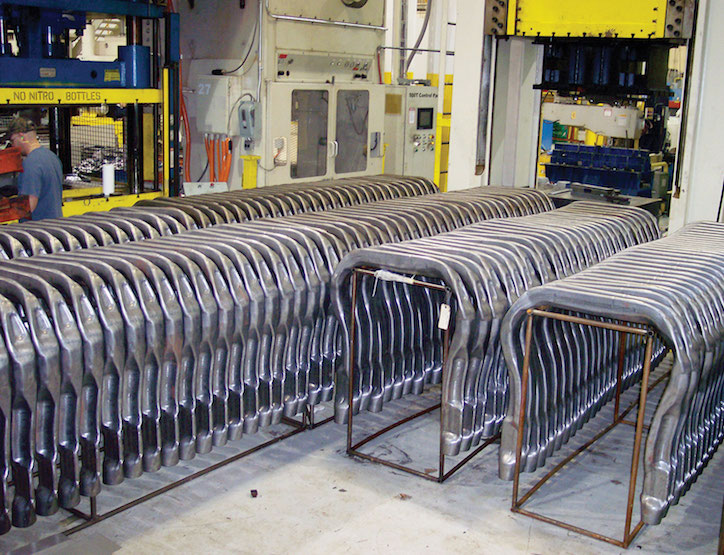
Strategies for Low-Volume Tooling
Conventional, long-life tooling is expensive, which often makes it unfeasible for low-volume production scenarios, which require specialized low-volume tooling. Without innovative thinking, high per-piece part/tooling costs can render even the best designs uncompetitive. Worse yet, new products might not even get to market!
So what do you do in a situation that calls for a low volume of parts? Let’s review some possible solutions and discuss the nuances of low-volume tooling.
Molds vs. Dies
Many products are assembled from molded or formed components. Plastic parts are injection molded, metal components are die-cast, sandcast, or forged, and sheet metal is stamped or drawn into complex forms. These processes drive up costs, but are necessary to achieve a particular appearance or level of performance.
Frequently, production tools for molding and forming are designed and manufactured for long life, high output rates and short cycle times. Hard materials are preferred, which means slow and expensive machining, followed by laborious finishing. Costs are high and lead times are long.
Low-Volume Tooling Needs Aren’t Unusual
Many industries face the conundrum of relatively low-volume needs and high tooling costs.
Medical device manufacturing is one example where small initial quantities are often needed for validation procedures.
Boat building is another industry where quantities are typically low but appearance and functionality cannot be compromised.
Even automotive companies often need small quantities of molded and formed parts for interim production and prototype and niche vehicles.
Alternative Approaches to Low-Volume Production
Lower volumes are an opportunity to explore alternative low-volume tooling strategies. When fewer parts will ultimately be produced, the emphasis on life and throughput should be superseded by greater considerations of tool cost, speed, part functionality, and aesthetics.
Consider Functional and Aesthetic Needs
Occasionally parts are needed that focus on the final look or “finish” of an item. If part strength and integrity are secondary, investigate alternative materials and production processes. It is important to note, though, that some low-volume processes will leave an inferior appearance.
The material itself can be an important consideration, too. For example, if thermal or electrical conductivity (or the converse, insulating properties) are important, this may preclude switching to a more easily shaped material.
Permissible Alternative Materials and Methods
Modern multi-axis CNC machines are fast and accurate, so it may be feasible to machine from a solid block of material. Two disadvantages are that machined parts may not have the strength of those produced by molding or forming, and material utilization is poor.
Rapid Prototyping Techniques
It’s uncommon for rapid prototyping (RP) to be a cost-effective method of low-volume production. 3D printing is slow and limited when it comes to the range of materials that can be used. Also, in many situations, the layered appearance is unacceptable, requiring extensive — and expensive — polishing and finishing.
However, rapid prototyping technologies can have a role in low-volume tooling. Rather than machining complex forms from a solid block of material, cores and molds can be produced by RP techniques. Their life will be shorter, but perhaps still sufficient for low-volume production.
When Low-Volume Production Must Use High-Volume Materials and Processes
As noted above, dies, molds, and form tools are usually designed and manufactured with high-volume production in mind. This leads to complex, multi-cavity molds made from materials that are hard to machine and expensive to finish.
However, for low-volume production, tool design can be simplified and alternative materials used. Here are some effective strategies for low-volume tooling.
- Single cavities. Multi-cavity molds provide high production rates but are expensive. When volumes are lower, a single cavity is often sufficient and significantly reduces mold costs. The same thinking applies to complex progressive die sets used for stamping sheet metal parts. Less complex, single operation tools will lower the output rate with the savings in tooling offsetting the higher piece cost.
- Modular tool design. Use interchangeable or exchangeable inserts that can be swapped in and out of standardized die sets. This allows changes in the form of the parts being molded, letting a single set of tooling make a family of parts rather than just one. It’s a particularly effective approach for scenarios in which parts like brackets or manifolds are needed in a range of sizes.
- Softer tooling. Wear rates will be higher and life will be significantly shorter, but why have tooling that outlasts the life of the product? This opens the door to less hard, less durable materials such as aluminum for low-volume tooling. These materials can be milled to final shape rather than being ground, which cuts time and saves money as a result. Aluminum has different thermal properties than steel, which must be taken into consideration, but this feature can also cut costs by eliminating the need for cooling galleries.
Thinking Differently About Tooling
Injection molding, die-casting, sandcasting, forging, and sheet metal stamping are widely used for cost-effective production. However, when volumes are lower, tooling costs can become prohibitive.
Sometimes it’s acceptable to compromise function or appearance by switching to alternative materials and processes to get low volumes of parts. More often, though, low-volume parts must be produced using high-volume methods so that materials, form, and functionality remain consistent. In such circumstances, low-volume tooling is required, which means rethinking the traditional approaches to tool manufacturing.
At the 3-Dimensional Services Group, problem solving is our specialty. If you need production-quality low-volume parts and need to produce them as cost-effectively — and quickly — as possible, we’ll no doubt have some suggestions. Contact us today to start the conversation.
